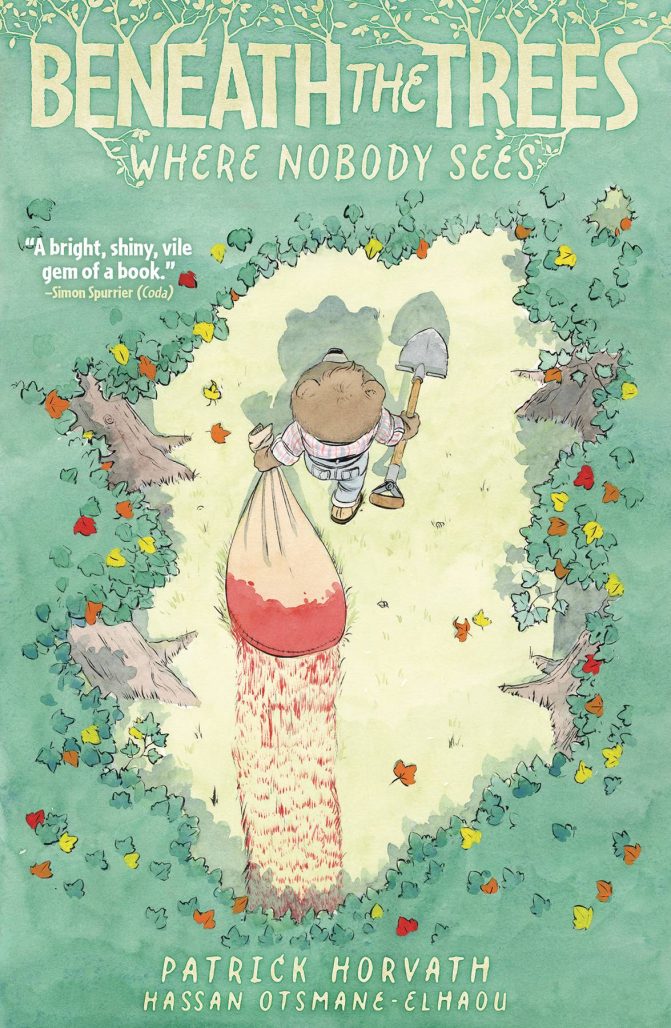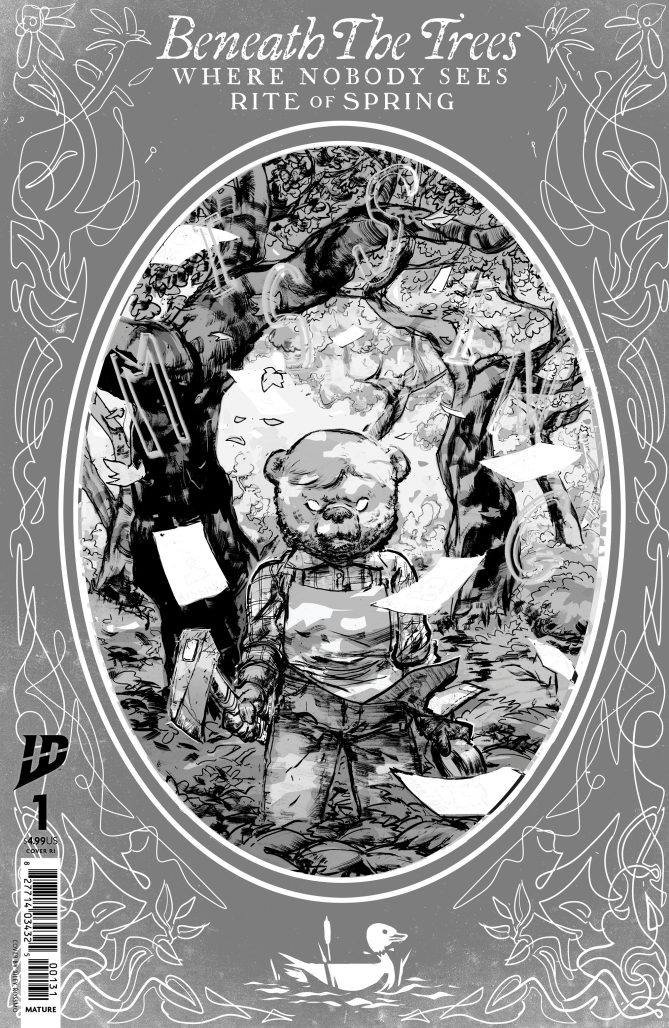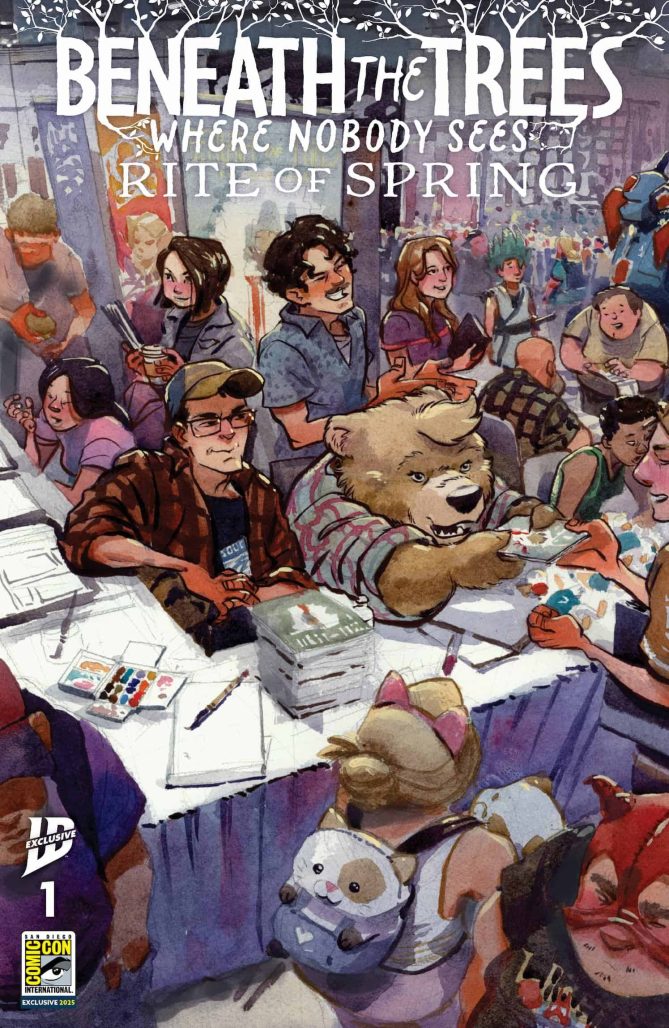IDW’s Beneath The Trees Where Nobody Sees was an incredible success last year, earning it a Best New Series Eisner nomination. This year, creator Patrick Horvath returned to San Diego Comic-Con with Beneath the Trees Where Nobody Sees: Rite of Spring.
The Beat spoke with Horvath at the con about his favorite bear, returning to SDCC, and the sequel, Rite of Spring.
Javier Perez: Thank you for talking to me. You got me started on collecting and getting my books graded. You made a remark on my copy of Beneath the Trees and asked me, “Are you sure you don’t want this slabbed?” And I said, “I don’t know, Patrick. I’ve never done that.”
But if Patrick Horvath is telling me to do this, I should probably do this. So now it’s a full-on addiction.
Patrick Horvath: Oh, right on. Well, I’m sorry for doing that, but I’m glad. I don’t know, I feel like it’s interesting to find a foothold in the comics world in terms of just reading and being a fan. And it just feels like that was sort of the first thing that happens and then end up being like, “I would like to do this too,” you know what I mean?
But the first thing is finding the thing that speaks to you. When I was like 14 or 15—no, probably a little earlier, like 12—when the speculator boom happened and I had some friends who were into comics, right at that time I was like, “Oh, I can get into this.” It felt like a weirdly open time because Image was starting out, and then you’re like, “Oh, sure, these are a bunch of number ones.” Like what a great time to just get into this thing.
I did it for a while, and that kind of set the foundation for me and comics and comic shops. It turned into something that sort of simmered on the back burner for a long time, and I wasn’t an avid collector for a long time. When I finally got to college, friends would show me different books that I should check out, and I bought some, like Charles Burns’ Black Hole, Chris Ware’s work, and Jimmy Corgan.
It wasn’t until around 2016 that I realized I very much wanted to do comics. I want to make comics. I had been drawing again at that point. For probably six years at that point, I was like, “I think it’s good enough, it’s up. I wouldn’t be embarrassed if I got this published.”
And then I actively started working with one writer, and we did some cold pitches. I would then self-publish my own books. But it was just like priming the pump, and then in 2020, I did Free for All just for myself. Then I did an issue for Haha with W. Maxwell Prince in like 2021, and that was the first time I ever got published by an actual publisher.
Perez: Free for All, that was initially a Kickstarter, right?
Horvath: I just made it because I wanted an example of semi-recent sequential work, especially in 2020, which has been very helpful. To confirm with W. Maxwell Prince that I could do interiors.
Perez: Yeah, that’s what I’m thinking, such immediate feedback.
Horvath: I was very encouraged by it. And then it wasn’t long after that that I spoke to Mark Doyle. He was with IDW as the director of editorial, and he liked my art. Then Paul Davidson, who was at IDW at the time, showed him my stuff he also told Doyle, “He’s a filmmaker too. He writes as well, so he can write and draw.” And that’s kind of how that happened.
I had a couple of pitches, and one of them was Beneath the Trees. But it’s funny because I’d been doing little comics on my own with just sequential art, basically. When I was like 4 or 5 I’d make these little books with my mom and then I would do strips and stuff, whatever, but it always felt like it was just from reading comic or comic strips and newspapers, then getting into comic books and thinking of longer form storytelling and then doing filmmaking.
And then, getting into comics, it’s funny because there’s a total foothold. There’s just a moment where you’re like. “Oh yeah, I understand the credible business side of it, where you have a shop where you can sell comics every week,” and that’s sort of like setting the foundation, like when I was like 12 or whatever. That’s like the bug of collecting comics and then it all just sort of builds on that, you know what I mean, in a weird way.
Perez: Talking about Beneath the Trees. What I really loved about the first arc was the surprise at the end. Let me know if I’m getting a little too heady on this one, but you kind of forgo that by telling us flat out what’s going on this time.
Samantha has gone through this, and Monica obviously has her own stuff. It’s so apparent that’s gonna be a clash. I’m wondering, how do you think about that juxtaposition of the way the story is going?
Horvath: So it felt like a really strong decision, and it felt necessary in order to tell this story, but we came to it in a really interesting way because it was initially gonna be three books. Then I conceptualized it as three and then there was a switch up: it would make way more sense to do it as six. Everybody’s expecting it to be six. We’ll keep it like that.
So the way that it had all sort of been structured at that point, I was like, well, our issue #1 would be really great if we had it like this, though, and the big question was like, “Can we just have a Monica book one, and then we’ll have Samantha also in it towards the end, but is that gonna fly?” And they’re like, “I don’t know, like we’ll find out.”
But everybody felt like it was such a good way into it. Now, seeing it done and reading it, it definitely felt like the right decision because you need this. You really need to be with Monica and really in her head. She’s starting at zero and we need to feel like she’s a credible foil for Samantha and to think that she’s gonna be like a problem for Samantha. That has to be in there. That was the main reason, and I feel like it’s very successful in doing that.
And it feels fun. Fun stuff’s gonna happen. It just felt like so much more.
Perez: Maybe it’s too many crime podcasts that I’m listening to but am I off in getting a feel of going back to the scene of the crime?
Horvath: Tthere’s something to that in the sense that Samantha’s not necessarily the literal scene of the crime, but for the first time, there’s this world of like—Monica’s on message boards and the Internet and [talking to] people trying to find solve cold cases or find loved ones that have been missing or whatever and so all that stuff is in the air now. It’s in the zeitgeist. True crime is becoming like a thing. The audience for that is becoming a thing.
Unsolved Mysteries is a huge one in terms of how it was just such a fascinating time for everyone. The monoculture just ingesting the idea of like, “Yes, there are cold cases. I understand that there are these unsolved mysteries.” When you do find out what happened, you’re compelled to find out why it happened.
We’re really exploring serial killers in the ’90s. People are becoming very actively fascinated with them because there’s less and less, but we’re also learning more and more about what happened in the past couple of decades. You have this weird spike of like around the late ’60s into the ’70s and ’80s of serial killers. It’s totally fascinating to me.
I have no idea about any of this, but it feels like it’s in this generation that comes up after the World War II generation has children. I think a lot of these children grew up in households with unprocessed trauma and I feel like there’s part of that wave that happened. Just speaking historically, socially, you know, and so that’s part of the reason why I wanted to take place in the ’90s.
Also, the world is changing. The world is shifting. The commerce of the world is shifting to global markets. Factories are moving overseas, stuff like that. So in terms of revisiting the scene of the crime, it feels like it’s almost the idea that the scene of the crime could just be, “Oh, everybody kind of knows about it now, but they don’t know who did it, right?”
Perez: You know the trope of it.
Horvath: For sure, for sure, but then also if you were Samantha and someone showed you a post of this thing, you’d be like, “Oh, that was me.” But people know about this, right? That, to me, was so fascinating to have this be a part of the setup.
Perez: That’s interesting in the sense that she would want that kind of attention.
Horvath: Never could have had it before. Yeah, this is insanely unique. I’m really amused by that concept.
Perez: In our time, you’re not going to get away with much crime due to surveillance. Looking back, it was way easier to get away with it; it was like the wild west.
Horvath: It’s so interesting when you think about just general criminals like, “I rob banks,” “I give bad checks,” or whatever. That was a different generation than the criminals that showed up in the mid-to-late ’80s and drug crime is becoming like a way different thing. I feel like it’s just such a bygone era, and the idea of being able to do illegal stuff and just get away with it has slowly evaporated to the point where it’s virtually impossible for a significant length of time now.
Perez: I also wanted to ask you about the convention. That’s kinda like going back to the scene of the crime, here at San Diego Comic-Con. How’s your experience?
Horvath: It was my first time here last year, and we also had an Eisner nomination. Everything felt very fast, but it’s very encouraging, and it just felt like a whirlwind, but in a really good way.
This time around, there are even more folks who know about the book. It’s incredible. And there are lots more fans, which is wonderful, but I’m also just feeling busier in general. Hence, it’s just like less time to be able to do functions and less time just to meet more people, to hang out with other creators that I know, because I’m actively also working on pages while I’m here, and then I’m hanging out with some signings, or panels, and things like that.
This time, I’m doing a panel, whereas I didn’t do one last time. Additionally, I have more signings scheduled this time than I did last time.
Perez: And you have a special variant for SDCC ’25. What was the process of finding that artist?
Horvath: The variant we have for San Diego is by Jerry Colm, and he is a watercolor cartoonist who also has a bear comic on the other spectrum.
It’s called Kodi book two is on the way, and he’s done other books as well, but it’s funny that he’s known for doing this bear book, and also I’m known for doing this bear book, but his is very much for like more friendly for children, and mine is very much not.
The Beneath the Trees cover is of the table at San Diego Comic-Con for a signing, and it’s me sitting next to Samantha while we’re signing books. Some editors are in the background. I think Jake Williams is there, and I believe Maggie Howell is in there too. If you look around, Colm definitely put some folks in it, which is fun, and he is a terrific artist. I was a fan of his before, and then—I knew the concept, but Jake, our editor, pitched it to Jared and got it done before I’d seen it. So it was like a total treat, super fun. I love it.
Perez: Is there anything you wanted to add or anything you want to let people know for the next issue?
Horvath: It’s a return to Woodbrook. We’re gonna see a lot of familiar faces, and we’re gonna touch on the lives of the folks that have survived the first arc that are still in Woodbrook. We’ll see how the events of that last book have shaped their lives. I’m really looking forward to that.
Perez: I appreciate it. Thank you for your time.

 13 hours ago
1
13 hours ago
1





 English (US)
English (US)